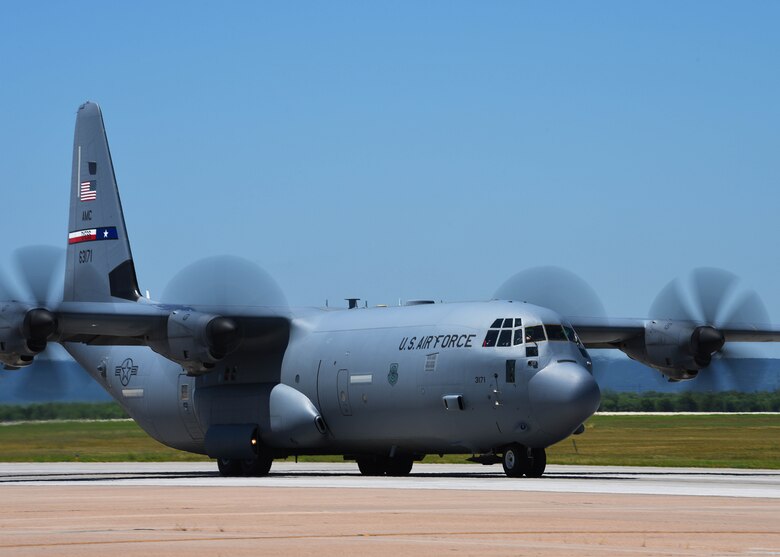The exercise, known as JFE Vul, is a large-scale air mobility exercise designed to simulate the joint forcible entry of paratroopers into a contested battlespace.
Although Little Rock and Dyess had separate mission planning cells, both were able to join each other's formation and head to the simulated JFE drop area.
"Training in a joint-base exercise is very realistic," said Maj. Darshan Subramanian, 317th Airlift Wing chief of tactics. "The ability for multiple mobility bases to synchronize effects from distributed locations is a critical component of future air mobility conflicts."
In total, the exercise featured approximately 75 aircraft who engaged in an intricate airdrop operation in a simulated enemy environment where sophisticated Integrated Air Defense Systems were employed.
JFE showcased that we as a military are able to maintain readiness on a national scale even amid the COVID-19 pandemic, said Capt. Patrick Waters, 61st Airlift Squadron pilot and 19th Airlift Wing planner for the Little Rock AFB-based aircraft.
"The C-130 community pulled together 19 tails, which is huge, especially amidst the pandemic," Waters said. "Airmen were brought in to launch, fuel and load the aircraft along with anything else we required to get off the ground and participate in this training."
Waters noted that the integration of forces in this particular exercise provided participants with a joint perspective on how to best support airdrop operations and assess air threats, surface-to-air threats and ground threats.
"Our main mission was to get Soldiers on the ground," Waters said. "This formation had many layers to ensure the paratroopers were able to start their descent … bomber aircraft cleared the airspace, fighter aircraft protected the C-130Js, and C-17 Globemaster IIIs dropped equipment the Soldiers needed to complete their mission."
Subramanian echoed Waters' sentiment, adding that the JFE allows us to practice the planning and muscle movements required to achieve mission success in a contested environment.
"The ability to airdrop the Army deep into enemy territory via C-130s while supported by the Combat Air Forces is a critical option for the national command authority when viewing options to project American strength," he said.
Air Mobility Command also dual-purposed the JFE construct by utilizing it as a testing ground for a tactical data link experiment intended to increase aircrew situational awareness of the threat environment before and during the mission.
The experimentation involved new computers aboard two C-17s, enabling high-speed data transfer via commercial satellites to the entire formation.
The commercial satellite link and new computers are intended to dramatically increase connection and refresh speeds, providing much more up-to-date information about the threat environment. Also, the network bandwidth allows for multiple users to connect, whereas the current capability becomes dramatically slower as users join the network.
"Pilots have used tactical data links to communicate through satellites for some time now," Waters said. "But instead of communicating as normal, the C-17 pilots used a new network band to communicate confidential information across the formation on a secure and rapid system."
Waters continued to say that investing in this level of communication allows for accelerated operations that will ultimately overwhelm adversaries with simultaneous challenges from every domain.

C-130J Super Hercules from Little Rock Air Force Base, Ark., fly in formation during Joint Forcible Entry exercise near Las Vegas, Nev., June 6, 2020. More than 20 C-130Js and C-17 Globemaster IIIs flew in formation during the U.S. Air Force Weapons School's Joint Forcible Entry exercise with numerous other aircraft from across the Air Force. (U.S. Air Force photo by Senior Airman Kristine M. Gruwell)

A loadmaster assigned to the 41st Airlift Squadron prepares a C-130J Super Hercules for flight at Little Rock Air Force Base, Ark., June 6, 2020. More than 20 C-130Js and C-17 Globemaster IIIs flew in formation during the U.S. Air Force Weapons School's Joint Forcible Entry exercise with numerous other aircraft from across the Air Force. (U.S. Air Force photo by Senior Airman Kristine M. Gruwell)

An C-130J Super Hercules prepares to depart Dyess Air Force Base, Texas, to participate in the U.S. Air Force Weapons School Joint Forcible Entry exercise June 6, 2020. The JFE exercise takes place at Nellis AFB, Nev. and is designed to be a large-scale air drop and land mobility mission. (U.S. Air Force photo by Senior Airman Mercedes Porter)






